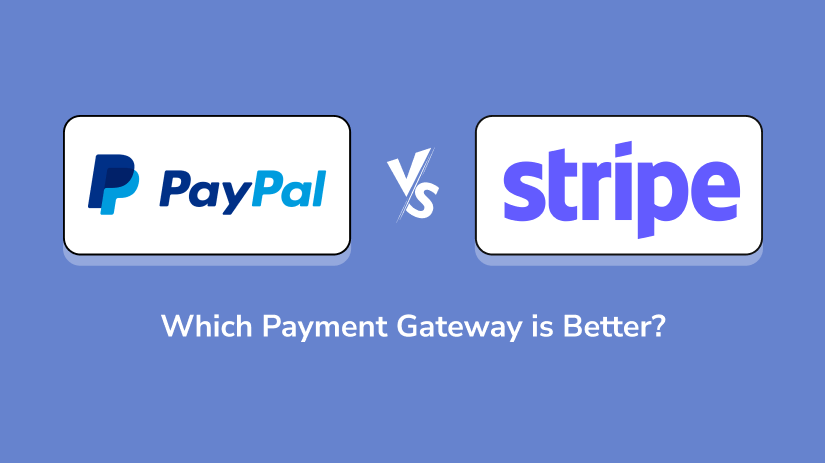In today’s digital age, where online transactions reign supreme, selecting the right payment gateway for your business is crucial. Among the plethora of options available, PayPal and Stripe stand out as two of the most popular choices.
Both offer a wide range of features and services, making it challenging to decide which one is better suited to your needs.
In this comprehensive guide, we’ll delve into the intricacies of PayPal vs Stripe, comparing their features, integrations, and overall suitability for various businesses.
PayPal Integration

PayPal has been a pioneer in online payments for decades, offering a trusted platform for sending and receiving money globally. Its integration services are versatile, allowing businesses to accept payments on their websites or mobile apps seamlessly. PayPal payment gateway integration is straightforward, making it a preferred choice for companies of all sizes.
Stripe Integration

On the other hand, Stripe has gained prominence in recent years, especially among tech-savvy businesses and startups. Known for its developer-friendly Stripe API and robust features, Stripe integration services enable businesses to customize their payment processes according to their specific requirements. Whether it’s integrating with a website, mobile app, or e-commerce platform, Stripe offers flexibility and scalability.
Connect with us for Fintech Development Needs
Trusted by companies like Plaid, Yodlee, Codat.
Features and Services of PayPal vs Stripe
Both PayPal and Stripe offer a range of features and services tailored to meet the diverse needs of businesses.
PayPal, with its extensive experience, provides a comprehensive suite of tools for payment processing, invoicing, and managing transactions. It also offers PayPal for companies, allowing businesses to streamline their financial operations.
On the other hand, Stripe focuses on providing advanced financial IT services, including payment processing, subscription billing, and fraud prevention.
Its emphasis on developer-centric solutions makes it a top choice for companies looking to build custom fintech software or integrate complex payment workflows into their platforms.
Developer Support and Flexibility of Stripe vs PayPal
When it comes to developer support, Stripe shines with its well-documented API, extensive libraries, and developer-friendly documentation.
Hire fintech developer experienced in Stripe integration is relatively straightforward, thanks to its popularity among the developer community.
While PayPal also offers integration support and resources for developers, some users find its documentation and APIs slightly less intuitive compared to Stripe. However, for businesses looking for a quick and easy setup, PayPal’s user-friendly interface and pre-built integration options can be advantageous.
Payment Gateway Integration PayPal vs Stripe
PayPal vs Stripe excels in providing seamless payment gateway integration for websites, mobile apps, and online platforms. Stripe API authentication and integration capabilities allow for a high level of customization, making it suitable for businesses with unique payment requirements.
PayPal, on the other hand, offers a range of integration options, including PayPal integration with WordPress, shipping integration, and custom integrations tailored to specific business needs. Its wide range of plugins and extensions make it easy to integrate PayPal into various platforms and applications.
Security and Compliance of PayPal vs Stripe
Security is paramount when it comes to online payments, and both PayPal and Stripe prioritize the safety of transactions. They adhere to industry standards and regulations, ensuring that customer data is protected and transactions are secure.
Stripe’s robust security measures, including tokenization and encryption, provide an extra layer of protection against fraud and unauthorized access. Similarly, PayPal employs advanced fraud detection tools and encryption protocols to safeguard sensitive information and prevent fraudulent activities.
Connect with us for Fintech Development Needs
Trusted by companies like Plaid, Yodlee, Codat.
Wrap-up of PayPal vs Stripe Payment Gateway
In conclusion, choosing between PayPal and Stripe ultimately depends on your business requirements, technical capabilities, and preferences.
PayPal, with its wide user base and user-friendly interface, is ideal for businesses looking for a reliable and easy-to-use payment solution.
On the other hand, Stripe appeals to businesses seeking flexibility, customization, and developer-friendly tools for building advanced payment workflows.
Whether you’re a small startup or a large enterprise, evaluating the features, services, and integration options of PayPal and Stripe will help you make the right choice for your business.
If you’re looking to integrate PayPal or Stripe into your website or app, consider hiring fintech developers or partnering with a financial software development company specializing in payment gateway integration.
With the right expertise and support, you can optimize your payment processes and enhance the overall user experience for your customers.
Frequently Asked Questions (FAQs)
1. Which payment gateway is better for small businesses: PayPal or Stripe?
Both PayPal and Stripe offer robust solutions for small businesses, but the better choice depends on your specific needs. PayPal is known for its user-friendly interface and global reach, making it a great option for businesses looking to accept payments from customers worldwide. On the other hand, Stripe offers advanced features and developer-friendly tools, making it ideal for businesses with more complex payment requirements. Ultimately, the best choice for your small business will depend on factors such as your target audience, transaction volume, and desired level of customization.
2. Can I integrate both PayPal and Stripe on my website or app?
Yes, it's possible to integrate both PayPal and Stripe on your website or app to offer customers multiple payment options. Many e-commerce platforms and payment processors support integration with both PayPal and Stripe, allowing you to provide a seamless checkout experience for your customers. Offering multiple payment gateways can help increase conversion rates and cater to a broader audience with varying preferences.
3. What are the transaction fees associated with PayPal and Stripe?
Both PayPal and Stripe charge transaction fees for processing payments, but the specific rates may vary depending on factors such as transaction volume, payment method, and geographic location. PayPal's transaction fees typically range from 2.9% + $0.30 per transaction for online payments in the United States, with additional fees for international transactions and currency conversions. Stripe's fees are similar, with rates starting at 2.9% + $0.30 per transaction for online payments in the United States, with variations for international transactions and alternative payment methods.
4. Are there any setup costs involved with using PayPal or Stripe?
Neither PayPal nor Stripe charge setup fees for creating an account or integrating their services into your website or app. Both platforms offer free account creation and provide access to developer tools and documentation to facilitate integration. However, keep in mind that there may be additional costs associated with certain features or services, such as advanced fraud protection or custom integration solutions. Be sure to review each platform's pricing and terms carefully to understand any potential costs beyond transaction fees
5. Can I use PayPal and Stripe for recurring payments and subscriptions?
Yes, both PayPal and Stripe support recurring payments and subscription billing, making them suitable choices for businesses offering subscription-based services or products. With PayPal, you can set up recurring billing plans and manage subscriptions through the PayPal website or API. Similarly, Stripe offers robust subscription management features, including flexible billing intervals, proration, and dunning management, to help businesses streamline their subscription billing processes. Whether you're billing customers monthly, annually, or on a custom schedule, both PayPal and Stripe provide the tools you need to automate and manage recurring payments effectively.





